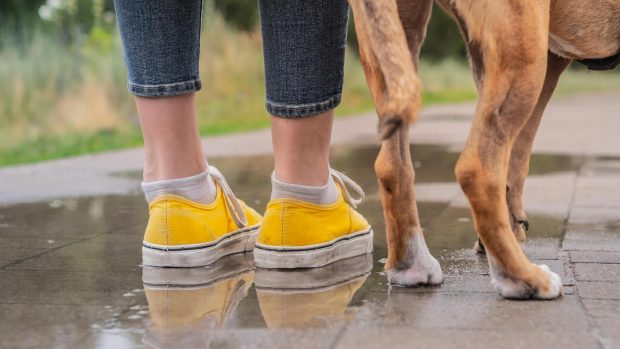Running with your dog is one of the best antidotes to the daily stresses of life. You benefit from the endorphins from exercising; serotonin, oxytocin and dopamine from being outside; and yet more oxytocin from the bonding time with your pet. But before working out how to run with a dog, you first need to assess whether it’s appropriate for him. Like any exercise, human or canine, you must build up gradually.
Not all dogs enjoy running – it depends on their age, character, breed and overall health. Take a look at this checklist to see whether it’s appropriate to kickstart a running plan – or a walking routine might be preferable.
- Age: Puppies shouldn’t run with you until their bones stop growing, to prevent joint injury. This varies according to breed, but estimate a minimum of nine months in small dogs, and up to 16 for larger ones. But there are plenty of ways to keep a puppy entertained in the meantime! At the other end of the scale, an old dog may be starting to slow down rather than speed up, so running probably won’t be ideal unless they are already well used to it.
- Breed: Dogs with congenital medical issues, and those with flat faces tend to struggle with breathing when doing vigorous exercise. Working dogs such as huskies, spaniels, pointers and retrievers tend to relish this sort of exercise as they have natural stamina and desire to work.
- Overall health: The best plan is to get your dog fully checked by a vet before you start a running programme. They will be able to advise on fitness levels and any underlying medical problems that may cause issues. Look for signs of fatigue – flattened ears, tail down, heavy panting, and hindlegs dragging are all signs that he is not coping with the exercise. If your dog has arthritis, while daily exercise is usually beneficial to keep him moving, faster, more strenuous work is not appropriate. And while you may want to take an overweight dog running to help it fight the flab, longer walks at a slower pace are advisable until he is in a leaner more athletic shape.
- Character: Just like us, some dogs simply don’t love running! Watch your dog while you’re out on a walk. Is he eager to move faster? Does he always want to catch up with you if you are ahead? You know your own dog, and should be able to tell whether running is something he’d relish. Remember that a big part of jogging with your dog is enjoying time together – and if he’s not happy, neither of you will enjoy it.
- Obedience: If you are planning to run with your dog off the lead, you need to be fully in command of his recall. It is handy to have one of the best pet GPS trackers fitted on your dog for running, because you will cover greater distances and are more likely to be on unfamiliar territory.
If your pooch ticks all of the above question marks, then let’s get started.
How to run with a dog
While you probably have your own running kit sorted, what about your dog’s? If your dog’s recall and obedience is sufficiently reliable, and you are running off-road, you may be able to run with your dog off the lead. This means they can move at their own pace. Often a human jog doesn’t quite tally with the speed a dog likes to travel – many dogs prefer to stop and sniff, then gallop in bursts, rather than consistently trot along for long periods.
But many running routes require the dog to be on a lead, or you may not yet be able to let your dog run free. H&H recommends using a running harness and lead. If your dog is a puller, a collar can be harsh on their necks, while even one of the best dog harnesses may restrict shoulder movement if it’s not designed for running. While other leads, harnesses and collar combos are great for lead-training and general walks, a specific running harness is lightweight, designed to fit comfortably and not rub.
Most lead training involves teaching your dog not to pull. However, you can teach your dog to differentiate between its usual walking lead and when you are happy for him to run and pull you along, such as in canicross, a brilliant sport for those who like running with their dog. If you want to get involved in canicross, you’ll definitely need to practise running with harness, bungee lead and belt. The elastic in the bungee lead ensures that when the dog starts pulling, there are no sudden jerks – which could cause injury such as muscle strain to both dog and runner. The Lasaline harness (which you can find on Amazon) is designed for pulling. You may need to try a couple of harnesses out as it needs to fit your dog really well. You’ll also need a belt and bungee lead, such as this one we found on Amazon.
Always monitor your dog’s wellbeing. He should find the exercise easy and enjoyable, and if he shows any signs of struggling you should drop back to a walk and build up slowly from shorter routes. He may not be a dog who enjoys life in the fast lane!

Lasaline Dog Pulling Harness | Amazon.co.uk
Available in eight sizes for the perfect fit, this X-back design provides an even distribution of pressure, while stabilising, supporting and protecting the back.

Handsfree Dog Lead | Amazon.co.uk
This lead attaches around your waist and it has a bungee to absorb shock and jerks if your dog pulls.
Make a plan
- Always work at the dog’s pace – if he’s not enjoying it, simply walk home. Obviously, if he wants to go longer and faster but you are not up to it, you can control this yourself but remember that he cannot decide to turn back when he’s had enough – you can!
- Start slowly. If you have never run with your dog before, start with a short jog of half the length of your usual walk and build up from there. Bear in mind that hills are hard going even for four legs, so factor this in to your route planning.
- Plan routes before you go, so that you are aware how often and when you have to cross roads, and how much time your dog can spend off lead. A great tactic is to walk new routes you plan to run together before you run it so that you aren’t surprised.
- The time of day is another factor. Your dog shouldn’t run on a full stomach, as it is not only comfortable but can cause them to be sick or even suffer a serious stomach upset, called Gastric Dilation Volvulus (twisted gut). Leave at least an hour after feeding.
- Check the weather. No one wants to be caught in a thunderstorm, and if you’re running on pavements, you won’t be able to avoid the mini tidal waves splashing over you from passing cars.
Kit to take with you
- Harness and lead
- Running belt. Most belts contain a small pocket that can carry a few items, otherwise you may need a lightweight running backpack.
- A doggy water bottle and bowl
- Mobile phone (with your vet’s phone number saved on it)
- Poo bags
- Dog whistle
- Pet tracker
Now you’re all set! Your dog should always find running with you easy, so remember to build up gradually, always monitoring his wellbeing and enjoyment. Have fun on your adventures together!

Sparkly Pets Handsfree Lead | Amazon.co.uk
This dog running belt has a support mechanism with two stainless steel clasps that take the tension off the plastic buckle and divide the pulling force across belt.

Dog Water Bottle | Amazon.co.uk
This 750ml bottle comes with a soft neoprene carrier, and the cap can be used as a drinking bowl.
Tractive GPS Tracker | Amazon.co.uk
See the location of your dog and track them anywhere with no distance limit so that you can run with your dog without worry.
You may also enjoy reading…

Best dog training leads to teach your pup obedience, heel work and recall

How to master loose lead walking

No more tug of war: 6 of the best anti-pull harnesses for dogs

Reliable recall: the best whistles to train your dog

The best waterproof canine coats to keep your dog cosy and dry whatever the weather

Subscribe to Horse & Hound magazine today – and enjoy unlimited website access all year round
Horse & Hound magazine, out every Thursday, is packed with all the latest news and reports, as well as interviews, specials, nostalgia, vet and training advice. Find how you can enjoy the magazine delivered to your door every week, plus options to upgrade your subscription to access our online service that brings you breaking news and reports as well as other benefits.




